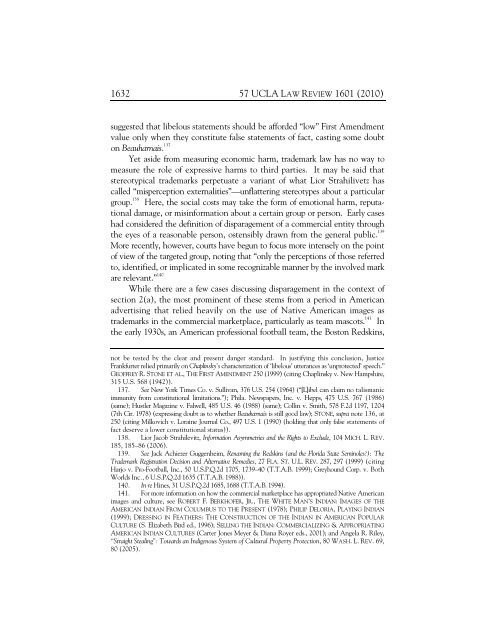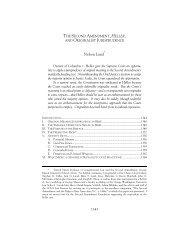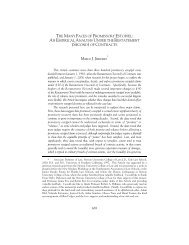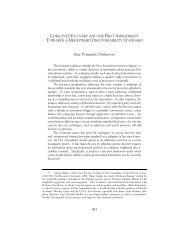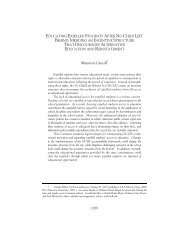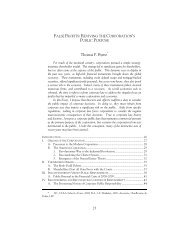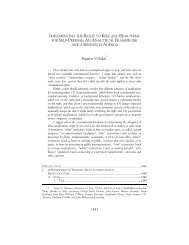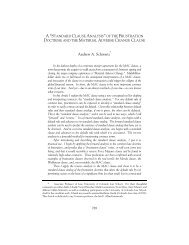Sonia K. Katyal - UCLA Law Review
Sonia K. Katyal - UCLA Law Review
Sonia K. Katyal - UCLA Law Review
Create successful ePaper yourself
Turn your PDF publications into a flip-book with our unique Google optimized e-Paper software.
1632 57 <strong>UCLA</strong> LAW REVIEW 1601 (2010)<br />
suggested that libelous statements should be afforded “low” First Amendment<br />
value only when they constitute false statements of fact, casting some doubt<br />
on Beauharnais. 137<br />
Yet aside from measuring economic harm, trademark law has no way to<br />
measure the role of expressive harms to third parties. It may be said that<br />
stereotypical trademarks perpetuate a variant of what Lior Strahilivetz has<br />
called “misperception externalities”—unflattering stereotypes about a particular<br />
group. 138<br />
Here, the social costs may take the form of emotional harm, reputational<br />
damage, or misinformation about a certain group or person. Early cases<br />
had considered the definition of disparagement of a commercial entity through<br />
the eyes of a reasonable person, ostensibly drawn from the general public. 139<br />
More recently, however, courts have begun to focus more intensely on the point<br />
of view of the targeted group, noting that “only the perceptions of those referred<br />
to, identified, or implicated in some recognizable manner by the involved mark<br />
are relevant.” 140<br />
While there are a few cases discussing disparagement in the context of<br />
section 2(a), the most prominent of these stems from a period in American<br />
advertising that relied heavily on the use of Native American images as<br />
trademarks in the commercial marketplace, particularly as team mascots. 141<br />
In<br />
the early 1930s, an American professional football team, the Boston Redskins,<br />
not be tested by the clear and present danger standard. In justifying this conclusion, Justice<br />
Frankfurter relied primarily on Chaplinsky’s characterization of ‘libelous’ utterances as ‘unprotected’ speech.”<br />
GEOFFREY R. STONE ET AL., THE FIRST AMENDMENT 250 (1999) (citing Chaplinsky v. New Hampshire,<br />
315 U.S. 568 (1942)).<br />
137. See New York Times Co. v. Sullivan, 376 U.S. 254 (1964) (“[L]ibel can claim no talismanic<br />
immunity from constitutional limitations.”); Phila. Newspapers, Inc. v. Hepps, 475 U.S. 767 (1986)<br />
(same); Hustler Magazine v. Falwell, 485 U.S. 46 (1988) (same); Collin v. Smith, 578 F.2d 1197, 1204<br />
(7th Cir. 1978) (expressing doubt as to whether Beauharnais is still good law); STONE, supra note 136, at<br />
250 (citing Milkovich v. Loraine Journal Co., 497 U.S. 1 (1990) (holding that only false statements of<br />
fact deserve a lower constitutional status)).<br />
138. Lior Jacob Strahilevitz, Information Asymmetries and the Rights to Exclude, 104 MICH. L. REV.<br />
185, 185–86 (2006).<br />
139. See Jack Achiezer Guggenheim, Renaming the Redskins (and the Florida State Seminoles?): The<br />
Trademark Registration Decision and Alternative Remedies, 27 FLA. ST. U.L. REV. 287, 297 (1999) (citing<br />
Harjo v. Pro-Football, Inc., 50 U.S.P.Q.2d 1705, 1739–40 (T.T.A.B. 1999); Greyhound Corp. v. Both<br />
Worlds Inc., 6 U.S.P.Q.2d 1635 (T.T.A.B. 1988)).<br />
140. In re Hines, 31 U.S.P.Q.2d 1685, 1688 (T.T.A.B. 1994).<br />
141. For more information on how the commercial marketplace has appropriated Native American<br />
images and culture, see ROBERT F. BERKHOFER, JR., THE WHITE MAN’S INDIAN: IMAGES OF THE<br />
AMERICAN INDIAN FROM COLUMBUS TO THE PRESENT (1978); PHILIP DELORIA, PLAYING INDIAN<br />
(1999); DRESSING IN FEATHERS: THE CONSTRUCTION OF THE INDIAN IN AMERICAN POPULAR<br />
CULTURE (S. Elizabeth Bird ed., 1996); SELLING THE INDIAN: COMMERCIALIZING & APPROPRIATING<br />
AMERICAN INDIAN CULTURES (Carter Jones Meyer & Diana Royer eds., 2001); and Angela R. Riley,<br />
“Straight Stealing”: Towards an Indigenous System of Cultural Property Protection, 80 WASH. L. REV. 69,<br />
80 (2005).


